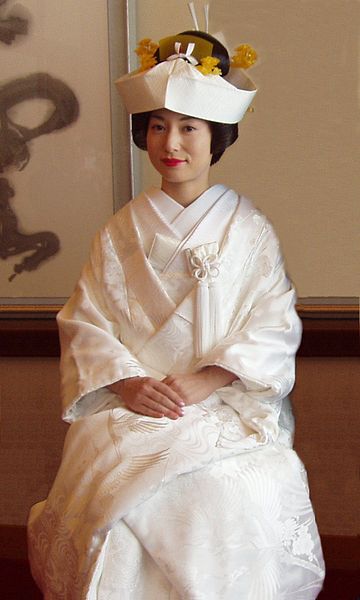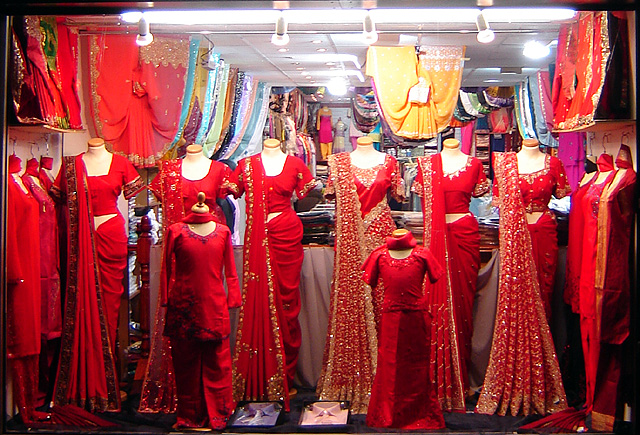 Weddings performed during and immediately after the medieval era were often little more than a union between two people. Could be a union between two families, two companies or two countries. Many weddings are more a matter of policy that love, especially among the nobility and higher social classes. Brides, therefore, are expected to dress in a way that cast their families in the most favorable light, as it did not represent themselves only during the ceremony. Brides of high social standing often wore rich colors and expensive fabrics. It is common to see such brides wearing bold colors and layers of fur, velvet and silk. Brides of a lower social status often copied the elegant styles of wealthier brides as best they could.
Weddings performed during and immediately after the medieval era were often little more than a union between two people. Could be a union between two families, two companies or two countries. Many weddings are more a matter of policy that love, especially among the nobility and higher social classes. Brides, therefore, are expected to dress in a way that cast their families in the most favorable light, as it did not represent themselves only during the ceremony. Brides of high social standing often wore rich colors and expensive fabrics. It is common to see such brides wearing bold colors and layers of fur, velvet and silk. Brides of a lower social status often copied the elegant styles of wealthier brides as best they could.

Wedding dresses have been traditionally based on the popular styles of the day. For example, in the 1920s, wedding dresses are typically short on the front with a longer train in the back and dressed in the style Cloche wedding veils. This tendency to follow current fashions continued until the late 1940s, when it became popular to re-time, full-skirted designs reminiscent of the Victorian era. Although there has always been a style that dominates the bridal market for a while, and then change with changes in fashion, an increasing number of modern brides are not choosing to follow these trends. This is largely due to non-traditional and non-first-time weddings, and the women who marry later in life. Today, wedding dresses Westerners are generally white, although "White Wedding" includes cream tones as eggshell and ivory color. One of the first women to use in her white wedding was Mary Queen of Scots, when she married Francis II of France. However, it was not then a white tradition, but rather a choice and see a little because the target was the official color of mourning in France at the time [2]. White does not become a popular choice until 1840, after the marriage of Queen Victoria to Prince Albert of Saxe-Coburg. Victoria had used a white dress for the event to incorporate some lace her property. The official wedding photograph was widely published, and many other brides opted for a similar dress in honor of the Queen of the election. [3] The tradition continues today in the form of a white wedding, even before the Victorian era was a bride married in any color except black (the color of mourning) or red (which was connected with prostitutes). However, in Finland during the 19th century, was popular for brides to bring dark colors, especially black. [4] Later, many people assumed that the white color was intended to symbolize virginity, although this has not been the original intention. (It is the blue color that was connected to purity.) Today, the white dress is meant only as the most traditional and popular choice for weddings, and not necessarily a statement of virginity



Eastern culture
Many wedding dresses in China are colored red, the traditional color of good luck. In modern Chinese wedding, the bride usually opts for the white Western dress or changes from a white coat with a red dress later in the day and, sometimes, a gold-colored dress later. Red wedding dresses are also popular in Vietnam in the traditional way of the Ao Dai. In Japan, brides are typically used three or more dresses throughout the ceremony and subsequent celebrations with a traditional kimono, white dress and is popular combination. Javanese people of Indonesia wear a kebaya, a traditional type of shirt with batik. A Barong Tagalog is considered common wedding attire of the Philippines and can be worn by both men and women.
In northern parts of India, the traditional color of women's wedding garments is red, a color symbolizing auspiciousness. Green, a color that symbolizes fertility, is also commonly used. Today, many women choose not to use red and opt for other colors. Weddings in southern India traditionally use white or cream-colored saris. Indian brides in Western countries often use the sari at the wedding ceremony and the traditional exchange in India after wear (like lehnga, Choli, etc.). Traditionally, India and Pakistan Brides are forced to hide their faces in the veil. In most liberal societies in India, just covering the head with a dupatta or so Sare is enough, but the traditional Pakistani society brides only needed to keep their faces hidden.


The indigenous peoples of the Americas have different traditions associated with weddings, and therefore wedding dresses. A Hopi bride traditionally would have their garments woven by the groom and men in all the people who want to participate. The clothing consists of a large belt, two all-white wedding dress, a white wedding gown with red stripes at the top and bottom, white buckskin leggings and moccasins, a string to tie the hair, and a reed mat on which to wrap the set. The package would also serve as a shroud, because such garments would be required for the journey through the underworld. People had a girlfriend tied a garment of cotton above the right shoulder, secured with a belt around the waist. In the traditions of Delaware, a girlfriend who uses a knee-length suede skirt and a band of Wampum beads around his forehead. Except in the case of pearls or necklaces of shell, the body was naked from the waist up. If it were a winter wedding, which was carried moccasins and deerskin leggings and a tunic of turkey feathers. His face was painted in white, red and yellow clay. The tribes of Northern California (including the Klamath, Modoc and the Yurok) had a traditional wedding dress woven in symbolic colors: white for the east, blue for the south, yellow (orange) to the west and black for the north. Turquoise and silver jewelry were used by both the bride and groom, plus a belt of silver shell. Jewelry is considered a shield against the evils including hunger, poverty and bad luck.


thanks for sharing this wedding dresses collection from different part of the world
ReplyDeleteI always like new dresses shoes and other accessories in shoes I like summer collection of Fly London Shoes
Realy great designs...
ReplyDeleteWe also have a huge collection of designer clothes like Sarees, salwar kameez and lehenga cholis visit - http://www.sareez.com/
Cheap Gold Jewelry is rather eye-candy jewelry for average-class people who cannot afford the shopping after a certain extent.
ReplyDeletethanks for this usefull article, waiting for this article like this again.
ReplyDeletesapphire rings
I found your this post while searching for information about blog-related research ... It's a good post .. keep posting and updating information.
ReplyDeleteopal ring